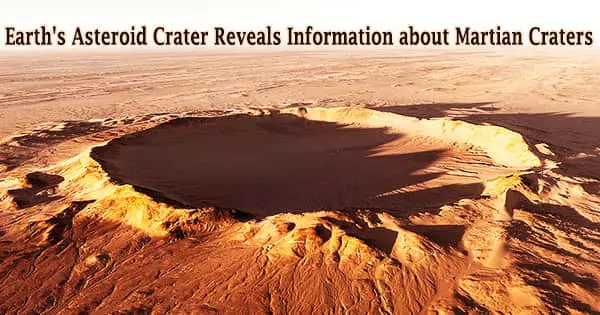The Nördlinger Ries is a nearly 15-million-year-old asteroid impact crater filled with lake sediments. Its structure is similar to the craters that are now being investigated on Mars.
The crater fill is mostly made up of layered clay deposits, in addition to several additional deposits on the basin’s rim. Surprisingly, a study team led by the University of Göttingen has detected a layer of volcanic ash in the asteroid’s crater.
When compared to craters on the Moon, Martian craters have an extraordinarily wide range of distinguishing shapes and features. Some are comparable to those found on the Moon, for example, those smaller than 5 km in diameter are bowl-shaped, with elevated rims and relatively flat floors, precisely like similar-sized craters on the Moon.
Craters on Mars are named after prominent scientists and science fiction authors, or after towns on Earth if they are less than 60 km (37 mi) in diameter. Craters cannot be named after living people, and minor crater names are rarely used to honor a particular town. With west longitude, latitude and longitude are provided as planetographic coordinates.
Furthermore, the team was able to demonstrate that the ground beneath the crater is sinking over time, which is crucial information for the exploration of craters on Mars, such as the ancient Gale and Jezero crater basin lakes, which are currently being explored by NASA Curiosity and Perseverance Rovers. The study’s findings were published in the journal Journal of Geophysical Research Planets.
It had been considered that these lake deposits had deposited on a stable crater bottom until now. The same is expected for crater deposits on Mars, despite the fact that some of them have steeply sloped sediment strata. The layers of these crater fill appear as ring-shaped formations on the surface.
Many scientists believe that the shape of ejecta blankets in medium-sized craters is determined by the amount of subsurface water present at the time the impactor collided with the surface. These craters are often referred to as “splosh” or “fluidized ejecta” craters because the ejecta resembles patterns seen when tossing boulders into fluid mud.
This is surprising, as volcanic rocks were not expected here since the circular basin was identified as an asteroid crater. The ash was blown in from a volcano 760 kilometers further east in Hungary. The age of the ash can be dated to 14.2 million years ago.
Professor Gernot Arp
However, reconstructing the chemical development of a crater lake and the habitability for hypothetical life-forms that may have developed there in the past requires a precise understanding of the underlying circumstances and temporal interrelationships of the deposits.
The researchers have discovered a volcanic ash layer in the lake sediments of the 330-meter-thick crater filling at the Ries for the first time.
“This is surprising, as volcanic rocks were not expected here since the circular basin was identified as an asteroid crater,” says first author Professor Gernot Arp from the Geosciences Centre at the University of Göttingen. “The ash was blown in from a volcano 760 kilometers further east in Hungary. The age of the ash can be dated to 14.2 million years ago,” adds his colleague and co-author István Dunkl.
The ash, which has now converted into nitrogen-rich silicate minerals, exhibits a very strong bowl-shaped geometry: the ash is located at the current ground surface at the basin’s border, while it rests at a depth of around 220 meters in the basin’s center.
The “outcropping strata” for the Ries crater filling are currently arranged in concentric rings, with the oldest deposits near the rim and the most recent in the center, according to a subsequent comprehensive review of drillings and geological mapping.
Calculations demonstrate that the underlying lake sediments are settling, although this bedding geometry cannot be explained simply by this. In fact, an extra 135 meters of the sinking had to be accounted for.
This can only be explained by crater bedrock subsidence, which is fragmented hundreds of meters deep. While more research is needed to understand the actual mechanics of the crater floor subsidence, a simple model calculation can already reveal that subsidence of this size is essentially achievable owing to cracked subterranean rock settlement.
This means that inclined strata in the fills of craters on Mars can now be better explained, at least for craters where crater formation, water flooding, and sedimentation all occur at the same time.
The German Research Foundation (DFG) financed the research. Geobiologists and sedimentologists from the University of Göttingen, the Bavarian Environment Agency, and Brown University in Providence, Rhode Island, were among the participants.





